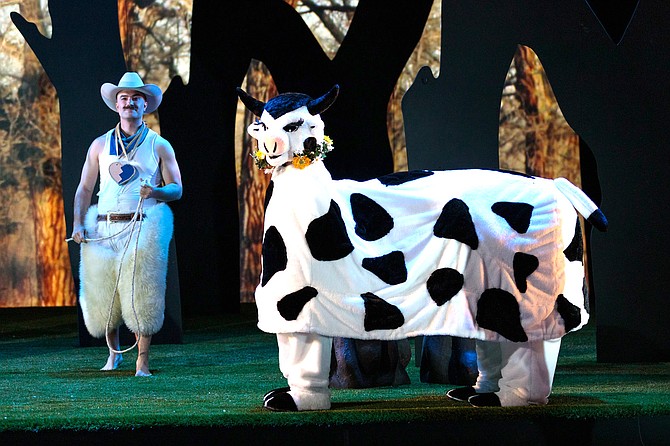 Facebook
Facebook
 X
X
 Instagram
Instagram
 TikTok
TikTok
 Youtube
Youtube

Given the final performances of Charles Gounod’s Romeo et Juliette are in the books, the San Diego Opera mainstage season is at an end. The season consisted of Mozart’s Cosi fan Tutte and the aforementioned Romeo.
Next year’s season has been announced. It will be an all Puccini affair with Gianni Schicchi/Suor Angelica and Tosca. There is also a world premiere of an opera about Frida Kahlo and Diego Rivera. It’s unclear if this is a part of the mainstage season or part of the Detour Series.
Also unclear is the future of opera in San Diego. It will be difficult to grow an opera community with only two opera productions per year. I do not count productions of the Detour Series such as the upcoming production of The Aging Magician at The Balboa Theatre. The proof is in the name. If we’re trying to get to opera, these productions are a detour. I don’t know about you but when I’m going somewhere, the last thing I’m looking for is a detour.
To reiterate the main point, two operas per year simply aren’t enough to develop an audience. Looking back at the history of the San Diego Opera, we can see that the last time there were only two productions was the 1970-1971 season.
In the 1980s, when Tito Capobianco ran the company from a tiny office in Balboa Park, San Diego Opera produced six operas per year. In the 1990s Ian Campbell reduced the number to five productions per year plus a recital or a special concert such as The Great Richard Wagner Concert in the 1998-1999 season.
The 2009-2010 season saw the number reduced to four productions after the financial disaster of 2008. The number stayed at four productions until Ian Campbell tried to shutter the company in 2014 citing that there was no way to continue the company at its current level. Campbell’s approach was to “wind down the company with dignity.”
San Diego Opera survived but the number of productions went down to three. The 2019-2020 season was reduced to two productions. With the 2022-2023 announcement, that makes four years of two production seasons.
I’m not a statistician but it would appear that the trend since 2008 has been one of reduction. In 2014 Ian Campbell was correctly villainized for how he handled the proposed shuttering of the company but perhaps he had a crystal ball.
Can opera make a comeback in San Diego? I think it can.
In the 1990s the San Diego Opera was growing while the San Diego Symphony went through two bankruptcies. Now the San Diego Symphony is thriving with $200 million worth of venue expansion and renovation.


Given the final performances of Charles Gounod’s Romeo et Juliette are in the books, the San Diego Opera mainstage season is at an end. The season consisted of Mozart’s Cosi fan Tutte and the aforementioned Romeo.
Next year’s season has been announced. It will be an all Puccini affair with Gianni Schicchi/Suor Angelica and Tosca. There is also a world premiere of an opera about Frida Kahlo and Diego Rivera. It’s unclear if this is a part of the mainstage season or part of the Detour Series.
Also unclear is the future of opera in San Diego. It will be difficult to grow an opera community with only two opera productions per year. I do not count productions of the Detour Series such as the upcoming production of The Aging Magician at The Balboa Theatre. The proof is in the name. If we’re trying to get to opera, these productions are a detour. I don’t know about you but when I’m going somewhere, the last thing I’m looking for is a detour.
To reiterate the main point, two operas per year simply aren’t enough to develop an audience. Looking back at the history of the San Diego Opera, we can see that the last time there were only two productions was the 1970-1971 season.
In the 1980s, when Tito Capobianco ran the company from a tiny office in Balboa Park, San Diego Opera produced six operas per year. In the 1990s Ian Campbell reduced the number to five productions per year plus a recital or a special concert such as The Great Richard Wagner Concert in the 1998-1999 season.
The 2009-2010 season saw the number reduced to four productions after the financial disaster of 2008. The number stayed at four productions until Ian Campbell tried to shutter the company in 2014 citing that there was no way to continue the company at its current level. Campbell’s approach was to “wind down the company with dignity.”
San Diego Opera survived but the number of productions went down to three. The 2019-2020 season was reduced to two productions. With the 2022-2023 announcement, that makes four years of two production seasons.
I’m not a statistician but it would appear that the trend since 2008 has been one of reduction. In 2014 Ian Campbell was correctly villainized for how he handled the proposed shuttering of the company but perhaps he had a crystal ball.
Can opera make a comeback in San Diego? I think it can.
In the 1990s the San Diego Opera was growing while the San Diego Symphony went through two bankruptcies. Now the San Diego Symphony is thriving with $200 million worth of venue expansion and renovation.
Comments